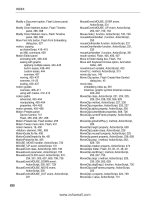Tài liệu 24 Adaptive Filters for Blind Equalization pptx
Bạn đang xem bản rút gọn của tài liệu. Xem và tải ngay bản đầy đủ của tài liệu tại đây (191.9 KB, 20 trang )
Zhi Ding. “Adaptive Filters for Blind Equalization.”
2000 CRC Press LLC. <>.
AdaptiveFiltersforBlind
Equalization
ZhiDing
AuburnUniversity
24.1Introduction
24.2ChannelEqualizationinQAMDataCommunication
Systems
24.3Decision-DirectedAdaptiveChannelEqualizer
24.4BasicFactsonBlindAdaptiveEqualization
24.5AdaptiveAlgorithmsandNotations
24.6MeanCostFunctionsandAssociatedAlgorithms
TheSatoAlgorithm
•
BGRExtensionsofSatoAlgorithm
•
ConstantModulusorGodardAlgorithms
•
Stop-and-GoAl-
gorithms
•
ShalviandWeinsteinAlgorithms
•
Summary
24.7InitializationandConvergenceofBlindEqualizers
ACommonAnalysisApproach
•
LocalConvergenceofBlind
Equalizers
•
InitializationIssues
24.8GloballyConvergentEqualizers
LinearlyConstrainedEqualizerWithConvexCost
24.9FractionallySpacedBlindEqualizers
24.10ConcludingRemarks
References
24.1 Introduction
Oneoftheearliestandmostsuccessfulapplicationsofadaptivefiltersisadaptivechannelequalization
indigitalcommunicationsystems.UsingthestandardleastmeanLMSalgorithm,anadaptive
equalizerisafinite-impulse-responseFIRfilterwhosedesiredreferencesignalisaknowntraining
sequencesentbythetransmitterovertheunknownchannel.Therelianceofanadaptivechannel
equalizeronatrainingsequencerequiresthatthetransmittercooperatesby(oftenperiodically)
resendingthetrainingsequence,loweringtheeffectivedatarateofthecommunicationlink.
Inmanyhigh-data-ratebandlimiteddigitalcommunicationsystems,thetransmissionofatraining
sequenceiseitherimpracticalorverycostlyintermsofdatathroughput.ConventionalLMSadaptive
filtersdependingontheuseoftrainingsequencescannotbeused.Forthisreason,blindadaptive
channelequalizationalgorithmsthatdonotrelyontrainingsignalshavebeendeveloped.Usingthese
“blind”algorithms,individualreceiverscanbeginself-adaptationwithouttransmitterassistance.
Thisabilityofblindstartupalsoenablesablindequalizertoself-recoverfromsystembreakdowns.
Thisself-recoveryabilityiscriticalinbroadcastandmulticastsystemswherechannelvariationoften
occurs.
c
1999byCRCPressLLC
In this section, we provide an introduction to the basics of blind adaptive equalization. We describe
commonly used blind algorithms, highlight important issues regarding convergence properties of
various blind equalizers, outline common initialization tactics, present several open problems, and
discuss recent advances in this field.
24.2 Channel Equalization in QAM Data Communication
Systems
In data communication, digital signals are transmitted by the sender through an analog channel to
the receiver. Nonideal analog media such as telephone cables and radio channels typically distort the
transmitted signal.
Theproblemofblindchannelequalization canbedescribedusingthesimple systemdiagram shown
in Fig. 24.1. The complex baseband model for a typical QAM (quadrature amplitude modulated)
data communication system consists of an unknown linear time-invariant (LTI) channel h(t) which
representsallthe interconnectionsbetween thetransmitter and thereceiveratbaseband. The matched
filter is also included in the LTI channel model. The baseband-equivalent transmitter generates a
sequence of complex-valued random input data {a(n)}, each element of which belongs to a complex
alphabet A (or constellation)of QAM symbols. The data sequence {a(n)}is sent through a baseband-
equivalent complex LTI channel whose output x(t) is observed by the receiver. The function of the
receiver is to estimate the original data {a(n)} from the received signal x(t).
FIGURE 24.1: Baseband representation of a QAM data communication system.
For a causal and complex-valued LTI communication channel with impulse response h(t), the
input/output relationship of the QAM system can be written as
x(t) =
∞
n=−∞
a(n)h(t − nT + t
0
) + w(t), a(n) ∈ A ,
(24.1)
where T is the symbol (or baud) period. Typically the channel noise w(t)is assumed to be stationary,
Gaussian, and independent of the channel input a(n).
In typical communication systems, the matched filter output of the channel is sampled at the
known symbol rate 1/T assuming perfect timing recovery. For our model, the sampled channel
output
x(nT ) =
∞
k=−∞
a(k)h(nT − kT + t
0
) + w(nT )
(24.2)
is a discretetime stationary process. Equation (24.2) relates the channelinputtothe sampled matched
filter output. Using the notations
x(n)
= x(nT ), w(n)
= w(nT ), and h(n)
= h(nT + t
0
),
(24.3)
c
1999 by CRC Press LLC
the relationship in (24.2) can be written as
x(n) =
∞
k=−∞
a(k)h(n − k) + w(n) .
(24.4)
When the channel is nonideal, its impulse response h(n) is nonzero for n = 0. Consequently,
undesirable signal distortion is introduced as the channel output x(n) depends on multiple symbols
in {a(n)}. This phenomenon, known as intersymbol interference (ISI), can severely corrupt the
transmitted signal. ISI is usually caused by limited channel bandwidth, multipath, and channel
fading in digital communication systems. A simple memoryless decision device acting on x(n) may
not be able to recover the original data sequence under strong ISI. Channel equalization has proven
to be an effective means of significant ISI removal. A comprehensive tutorial on nonblind adaptive
channel equalization by Qureshi [2] contains detailed discussions on various aspects of channel
equalization.
FIGURE 24.2: Adaptive blind equalization system.
Figure24.2 showsthe combinedcommunication system with adaptive equalization. In this system,
the equalizer G(z, W) is a linear FIR filter with parameter vector W designed to remove the distortion
caused by channel ISI. The goal of the equalizer is to generate an output signal y(n) that can be
quantized to yield a reliable estimate of the channel input data as
ˆa(n) = Q
(
y(n)
)
= a(n − δ) ,
(24.5)
where δ is a constant integer delay. Typically any constant but finite amount of delay introduced by
the combined channel and equalizer is acceptable in communication systems.
The basic task of equalizing a linear channel can be translated to that task of identifying the
equivalent discrete channel, defined in z-transform notation as
H(z) =
∞
k=0
h(k)z
−k
.
(24.6)
With this notation, the channel output becomes
x(n) = H (z)a(n) + w(n)
(24.7)
where H (z)a(n) denotes linear filtering of the sequence a(n) by the channel and w(n) isawhite(for
a root-raised-cosine matched filter [2]) stationary noise with constant power spectrum N
0
. Once
c
1999 by CRC Press LLC
FIGURE 24.3: Decision-directed channel equalization algorithm.
the channel has been identified, the equalizer can be constructed according to the minimum mean
square error (MMSE) criterion between the desired signal a(n − δ) and the output y(n) as
G
mmse
(z, W) =
H
∗
(z
−1
)z
−δ
H(z)H
∗
(z
−1
) + N
0
,
(24.8)
where ∗ denotes complex conjugate. Alternatively, if the zero-forcing (ZF) criterion is employed,
then the optimum ZF equalizer is
G
zf
(z, W) =
z
−δ
H(z)
,
(24.9)
which causes the combined channel-equalizer response to become a purely δ-sample delay with zero
ISI. ZF equalizers tend to perform poorly when the channel noise is significant and when the channels
H(z)have zeros near the unit circle.
Both the MMSE equalizer (24.8) and the ZF equalizer (24.9) are of a general infinite impulse
response (IIR) form. However, adaptive linear equalizers are usually implemented as FIR filters due
to the difficulties inherent in adapting IIR filters. Adaptation is then based on a well-defined criterion
such as the MMSE between the ideal IIR and truncated FIR impulse responses or the MMSE between
the training signal and the equalizer output.
24.3 Decision-Directed Adaptive Channel Equalizer
Adaptive channel equalization was first developed by Lucky [1] for telephone channels. Figure 24.3
depicts the traditional adaptive equalizer. The equalizer begins adaptation with the assistance of a
known training sequence initially transmitted over the channel. Since the training signal is known,
standard gradient-based adaptive algorithms such as the LMS algorithm can be used to adjust the
equalizer coefficients to minimize the mean square error (MSE) between the equalizer output and the
training sequence. It is assumed that the equalizer coefficients are sufficiently close to their optimum
values and that much of the ISI is removed by the end of the training period. Once the channel
input sequence {a(n)} can be accurately recovered from the equalizer output through a memoryless
decision device such as a quantizer, the system is switched to the decision-directed mode whereby
the adaptive equalizer obtains its reference signal from the decision output.
One can construct a blind equalizer by employing decision-directed adaptation without a training
sequence. The algorithm minimizes the MSE between the quantizer output
ˆa(n − δ) = Q(y(n))
(24.10)
c
1999 by CRC Press LLC
andthe equalizeroutput y(n). Naturally,theperformanceofthedecision-directedalgorithmdepends
on the accuracy of the estimate Q(y(n)) for the true symbol a(n − δ). Undesirable convergence to a
local minimum with severe residual ISI can occur in this situation such that Q(y(n)) and a(n − δ)
differ sufficiently often. Thus, the challenge of blind equalization lies in the design of special adaptive
algorithms that eliminate the need for training without compromising the desired convergence to
near the optimum MMSE or ZF equalizer coefficients.
24.4 Basic Facts on Blind Adaptive Equalization
In blind equalization, the desired signal or input to the channel is unknown to the receiver, except
for its probabilistic or statistical properties over some known alphabet A. As both the channel h(n)
and its input a(n) are unknown, the objective of blind equalization is to recover the unknown input
sequence based solely on its probabilistic and statistical properties.
The first comprehensive analytical study of the blind equalization problem was presented by Ben-
veniste, Goursat, and Ruget in 1980 [3]. In fact, the very term “blind equalization” can be attributed
to Benveniste and Goursat from the title of their 1984 paper [4]. The seminal paper of Benveniste
et al. [3] established the connection between the task of blind equalization and the use of higher
order statistics of the channel output. Through rigorous analysis, they generalized the original Sato
algorithm [5] into a class of algorithms based on non-MSE cost functions. More importantly, the
convergence properties of the proposed algorithms were carefully investigated. Based on the work
of [3], the following facts about blind equalization are generally noted:
1. Second order statistics of x(n) alone only provide the magnitude information of the
linear channel and are insufficient for blind equalization of a mixed phase channel H(z)
containing zeros inside and outside the unit circle in the z-plane.
2. A mixed phase linear channel H(z)cannot be identified from its outputs when the input
signal is i.i.d. Gaussian, since only second order statistical information is available.
3. Although the exact inverse of a nonminimum phase channel is unstable, a truncated
anticausal expansioncan be delayed by δ to allowa causalapproximation to a ZF equalizer.
4. ZF equalizers cannot be implemented for channels H(z)with zeros on the unit circle.
5. The symmetry of QAM constellations A ⊂ C causes an inherent phase ambiguity in the
estimateof thechannelinput sequenceor theunknownchannel when inputtothechannel
is uniformly distributed over A. This phase ambiguity can be overcome by differential
encoding of the channel input.
Due to the absence of a training signal, it is important to exploit various available information
about the input symbol and the channel output to improve the quality of blind equalization. Usually,
the following information is available to the receiver for blind equalization:
• The power spectral density (PSD) of the channel output signal x(t), which contains
information on the magnitude of the channel transfer function;
• The higher-order statistics (HOS) of the T -sampled channel output {x(kT)}, which
contains information on the phase of the channel transfer function;
• Cyclostationary second andhigher orderstatistics of thechanneloutput signal x(t), which
contain additional phase information of the channel; and
• The finite channel input alphabet, which can be used to design quantizers or decision
devices with memory to improve the reliability of the channel input estimate.
Naturally in some cases, these information sources are not necessarily independent as they contain
overlapping information. Efficient and effective blind equalization schemes are more likely to be
c
1999 by CRC Press LLC
designed when all useful information is exploited at the receiver. We now describe various algorithms
for blind channel identification and equalization.
24.5 Adaptive Algorithms and Notations
There are basically two different approaches to the problem of blind equalization. The stochastic
gradient descent(SGD) approachiteratively minimizesa chosencostfunctionoverall possiblechoices
of the equalizer coefficients, while the statistical approach uses sufficient stationary statistics collected
over a block of received data for channel identification or equalization. The latter approach often
exploits higher order or cyclostationary statistical information directly. In this discussion, we focus
on the the adaptive online equalization methods employing the the gradient descent approach, as
these methods are most closely related to other topics in this chapter. Consequently, the design of
special, non-MSE cost functions that implicitly exploits the HOS of the channel output is the key
issue in our methods and discussions.
For reasons of practicality and ease of adaptation, a linear channel equalizer is typically imple-
mented as an FIR filter G(z, W). Denote the equalizer parameter vector as
W
=
[
w
0
w
1
··· w
m
]
T
,m<∞ .
In addition, define the received signal vector as
X(n)
=[x(n) x(n − 1) ... x(n− m) ]
T
.
(24.11)
The output signal of the linear equalizer is thus
y(n) = W
T
X(n)
= G(z, W){x(n)} ,
(24.12)
where we have defined the equalizer transfer function as
G(z, W) =
m
i=0
w
i
z
−i
.
(24.13)
All the ISI is removed by a ZF equalizer if
H (z)G(z, W) = gz
−δ
,g= 0
(24.14)
such that the noiseless equalizer output becomes y(n) = ga(n − δ),whereg is a complex-valued
scaling factor. Hence, a ZF equalizer attempts to achieve the inverse of the channel transfer function
with a possible gain difference g and/or a constant time delay δ.
Denoting the parameter vector of the equalizer at sample instant n as W(n), the conventional LMS
adaptive equalizer employing a training sequence is given by
W(n + 1) = W(n) + µ[a(n − δ) − y(n)]X(n) ,
(24.15)
where ·
∗
denotes complex conjugates and µ is a small positive stepsize. Naturally, this algorithm
requires that the channel input a(n − δ) be available. The equalizer iteratively minimizes the MSE
cost function
E
|e
n
|
2
= E{|a(n − δ) − y(n)|
2
} .
c
1999 by CRC Press LLC
If the MSE is so small after training that the equalizer output y(n) is a close estimate of the true
channel input a(n − δ), then Q(y(n)) can replace a(n − δ) in a decision-directed algorithm that
continues to track modest time-variations in the channel dynamics [2].
In blind equalization, the channel input a(n − δ) is unavailable, and thus different minimization
criteria are explored. The crudest blind equalization algorithm is the decision-directed scheme that
updates the adaptive equalizer coefficients as
W(n + 1) = W(n) + µ[Q(y(n)) − y(n)]X
∗
(n) .
(24.16)
The performance of the decision-directed algorithm depends on how close W(n) is to its optimum
setting W
opt
under the MMSE or the ZF criterion. The closer W(n) is to W
opt
, the smaller the ISI is
and the more accurate the estimate Q(y(n)) is to a(n − δ). Consequently, the algorithm in (24.16)
is likely to converge to W
opt
if W(n) is initially close to W
opt
. The validity of this intuitive argument
is shown analytically in [6, 7]. On the other hand, W(n) can also converge to parameter values that
do not remove sufficient ISI from certain initial parameter values W(0),asQ(y(n)) = a(n − δ)
sufficiently often in some cases [6, 7].
The ability of the equalizer to achieve the desired convergence result when it is initialized with
sufficiently small ISI accounts for the key role that the decision-directed algorithm plays in channel
equalization. In the system of Fig. 24.3, the training session is designed to help W(n) converge
to a parameter vector such that most of the ISI has been removed, from which adaptation can be
switched to the decision-directed mode. Without direct training, a blind equalization algorithm
is therefore used to provide a good initialization for the decision-directed equalizer because of the
decision-directed equalizer’s poor convergence behavior under high ISI.
24.6 Mean Cost Functions and Associated Algorithms
Under thezero-forcing criterion, the objectiveoftheblindequalizeristoadjustW(n)suchthat(24.14)
can be achieved using a suitable rule of self-adaptation. We now describe the general methodology
of blind adaptation and introduce several popular algorithms.
Unless otherwise stated, we focus on the blind equalization of pulse-amplitude modulation (PAM)
signals, in which the input symbol is uniformly distributed over the following M levels,
{±(M − 1)d, ±(M − 3)d, ..., ±3d, ±d },Meven .
(24.17)
We study this particular case because (1) algorithms are often defined only for real signals when first
developed [3, 5], and (2) the extension to complex (QAM) systems is generally straightforward [4].
Blind adaptive equalization algorithms are often designed by minimizing special non-MSE cost
functions that do not involve the use of the original input a(n) but still reflect the current level of ISI
in the equalizer output. Define the mean cost function as
J(W)
= E{(y(n))} ,
(24.18)
where (·) is a scalar function of its argument. The mean cost function J(W) should be specified
such that its minimum point W corresponds to a minimum ISI or MSE condition. Because of the
symmetric distribution of a(n) over A in 24.17, the function should be even ((−x) = (x)),
so that both y(n) = a(n − δ) and y(n) =−a(n − δ) are desired objectives or global minima of the
mean cost function.
Using 24.18, the stochastic gradient descent minimization algorithm is easily derived as [3]
W(n + 1) = W(n) − µ ·
∂
∂W(n)
(y(n))
= W(n) − µ ·
X
T
(n)W(n)
X
∗
(n) .
(24.19)
c
1999 by CRC Press LLC









